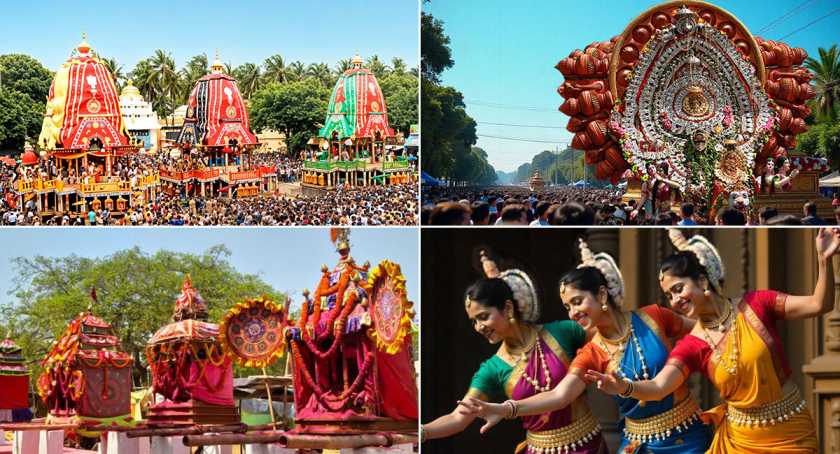Odisha Preserves Ancient Traditions in the Modern Era
Odisha, a state on India’s eastern coast, is a land where the past and present coexist harmoniously. Odisha has a rich cultural legacy that stretches back thousands of years, and it has embraced modernity while preserving its long-standing customs. From its classical dance forms and intricate handlooms to grand festivals and temple rituals, the state continues to celebrate its timeless customs amidst rapid globalization.
Let’s examine how Odisha has maintained its customs in today’s rapidly evolving world.
Classical Arts and Dance: Keeping the Rhythm Alive
Odissi, one of India’s eight classical dance forms, originated in Odisha and remains a symbol of the state’s artistic excellence. Despite modern entertainment options dominating the cultural scene, institutions like the Odisha Dance Academy and Guru Kelucharan Mohapatra Odissi Research Centre continue to train young dancers in this intricate art form. Additionally, global recognition and international performances have helped Odissi thrive beyond the borders of India, ensuring its legacy for future generations.
Handlooms and Handicrafts: Weaving the Past into the Future
Odisha’s handloom industry is evidence of the state’s commitment to preserving its weaving traditions. The Sambalpuri, Bomkai, and Kotpad sarees are renowned for their beautiful craftsmanship and unique patterns. The government and private organizations have introduced digital platforms and e-commerce initiatives to support weavers and promote their work, allowing artisans to reach a wider audience while sustaining their traditional livelihood.
Similarly, Odisha’s handicrafts, including Pattachitra paintings, filigree silverwork, and appliqué work from Pipili, have received national and international acclaim. Establishing dedicated craft villages and cultural hubs, such as Raghurajpur, ensures these ancient art forms flourish in a modern economy.
Temples and Religious Practices: Faith in Continuity
Odisha is home to some of India’s most iconic temples, such as the Jagannath Temple in Puri, the Lingaraj Temple in Bhubaneswar, and the Konark Sun Temple. These temples serve as hubs for cultural heritage and houses of worship. The annual Rath Yatra of Lord Jagannath attracts millions of devotees and remains a significant event that embodies Odisha’s spiritual ethos.
Despite modernization, priests continue to perform temple rituals with the same dedication and adherence to ancient scriptures. The Puri temple’s kitchen, which follows time-honored traditions in preparing Mahaprasad, is a remarkable example of Odisha’s commitment to preserving its religious practices.
Festivals: Bridging the Ancient and the Contemporary
Festivals play a crucial role in preserving Odisha’s culture. Events like Durga Puja, Raja Parba, Nuakhai, and Makar Sankranti are celebrated with immense fervor, blending age-old traditions with modern expressions of joy. Even with changing lifestyles, families continue to engage in traditional rituals, ensuring that these festivities remain vital to Odia’s identity.
The international promotion of these festivals, such as showcasing the Rath Yatra in global cities, has helped keep Odisha’s traditions alive on a larger stage and attracted cultural enthusiasts worldwide.
Language and Literature: Keeping Odia Thriving
The literary heritage of Odia, one of India’s oldest languages, stretches back more than a millennium. Online publications, digital dictionaries, and a drive for Odia-medium instruction in schools have all been part of the language’s preservation and promotion efforts. The Sahitya Akademi Award-winning writers and the digitization of ancient Odia manuscripts have also played a key role in keeping the language relevant in the digital age.
Tribal Traditions: The Soul of Odisha’s Heritage
More than 60 indigenous communities with distinctive customs, artwork, and traditions can be found in Odisha. Festivals, dance forms like Dhemsa, and traditional tribal crafts preserve these indigenous cultures. Organizations and government initiatives are actively working to document and promote tribal heritage through exhibitions, tourism, and community-driven development programs.
Cuisine: A Taste of Tradition in a Modern Kitchen
Odisha’s cuisine is deeply rooted in tradition. Dishes like Dalma, Pakhala Bhata, and Chhena Poda are unique in Odia households. While modern restaurants and cafes offer diversified food choices, many eateries continue to serve authentic Odia dishes, ensuring that traditional flavors remain accessible to the younger generation.
Moreover, efforts to popularize Odia cuisine through cooking shows, food festivals, and digital content have helped bring these age-old recipes into contemporary culinary discussions.
Performing Arts and Folk Culture: Storytelling Through Time
Odisha’s folk arts, such as Daskathia, Pala, and Jatra, have entertained audiences for centuries. While urbanization has led to the decline of some of these art forms, initiatives by cultural organizations and the government have revitalized interest through stage performances, digital recordings, and festival showcases.
Odisha’s storytelling tradition passed down through generations, continues to thrive in modern formats, including radio plays and digital podcasts, ensuring that folklore remains an integral part of Odia culture.
Museums and Heritage Conservation: Protecting the Past
Odisha has taken significant steps to preserve its historical and cultural legacy through museums and conservation projects. Institutions like the Odisha State Museum, Tribal Museum, and Konark Interpretation Centre showcase the state’s rich history and traditions. Restoration projects for ancient temples and palaces ensure that Odisha’s architectural heritage remains intact for future generations.
Education and Awareness: Nurturing the Future Guardians of Culture
Incorporating Odisha’s cultural legacy will make the educational system a winner. Odisha has primarily preserved its Schools and universities to ensure young minds are exposed to their cultural roots by offering Odissi dance, classical music, and traditional arts courses. Workshops, seminars, and cultural exchange programs further encourage the youth to take an active interest in their heritage.
Final Thoughts
Odisha is a shining example of how a region can embrace modernity without losing its cultural essence. In a rapidly changing world, the world upholds its long-standing traditions through hard work in literature, the arts, cuisine, festivals, and religion. Because of its commitment to preserving its rich heritage, future generations will always have access to the cultural treasures of their ancestors.
In this seamless blend of tradition and modernity, Odisha continues to be a land where history breathes through every dance movement, temple ritual, and handcrafted masterpiece—a testament to the state’s unwavering cultural pride.


